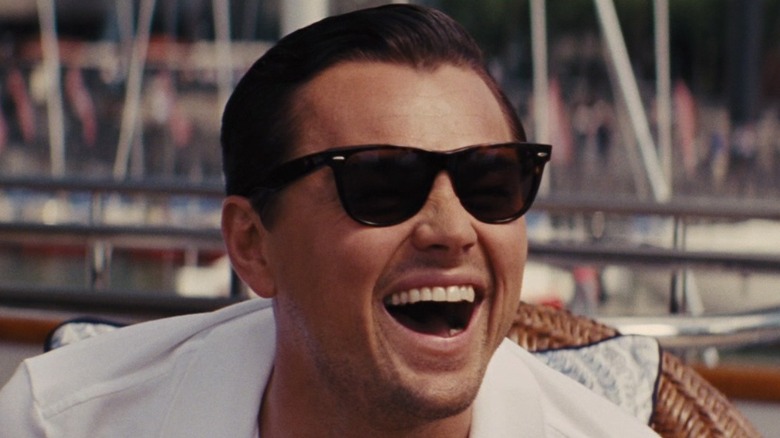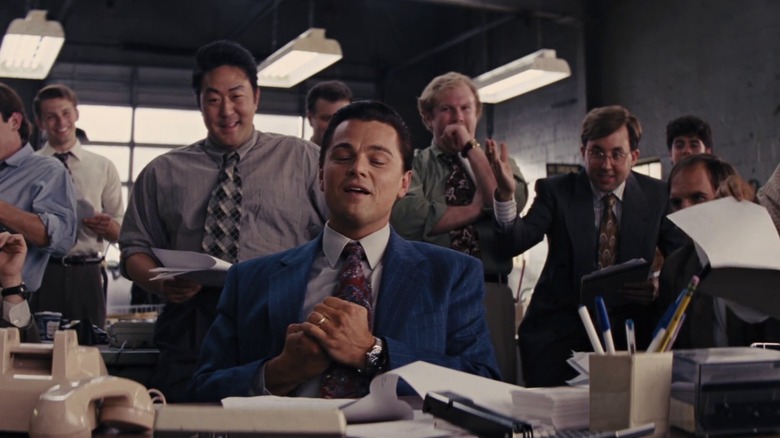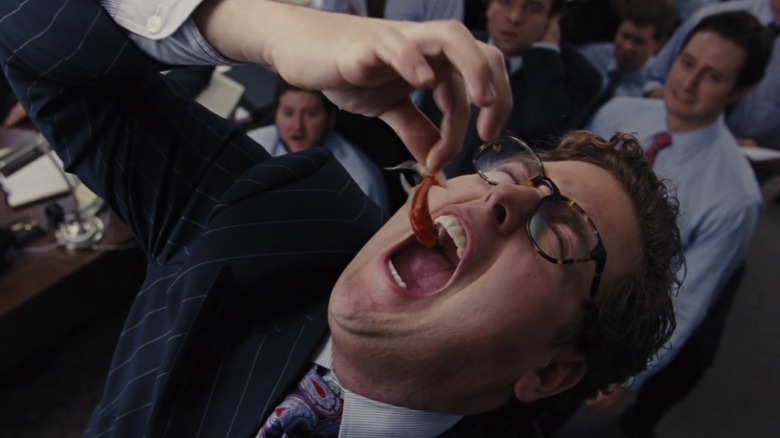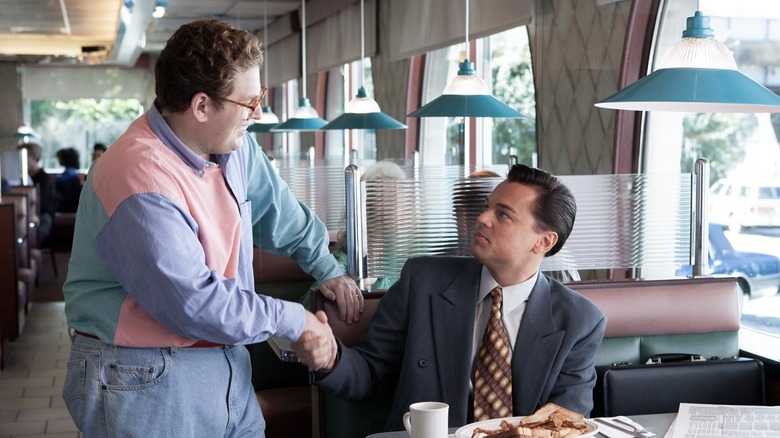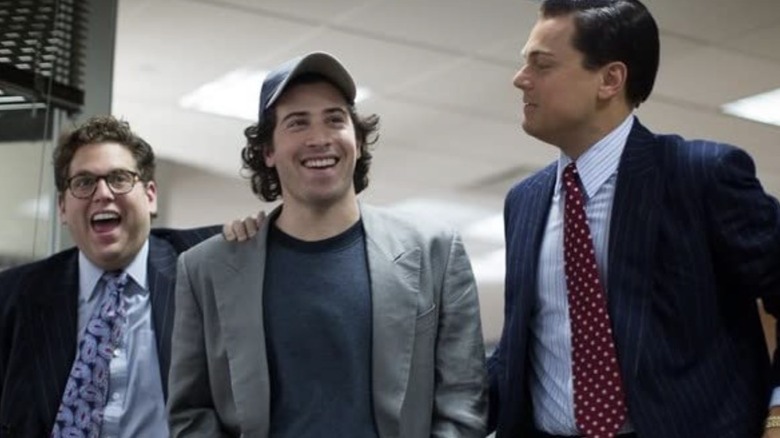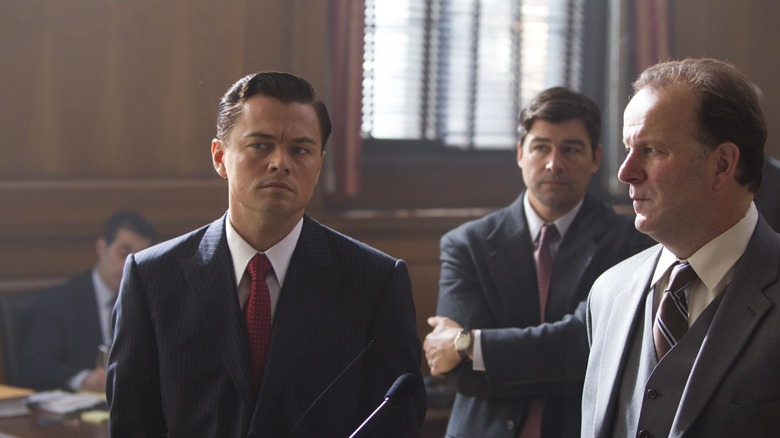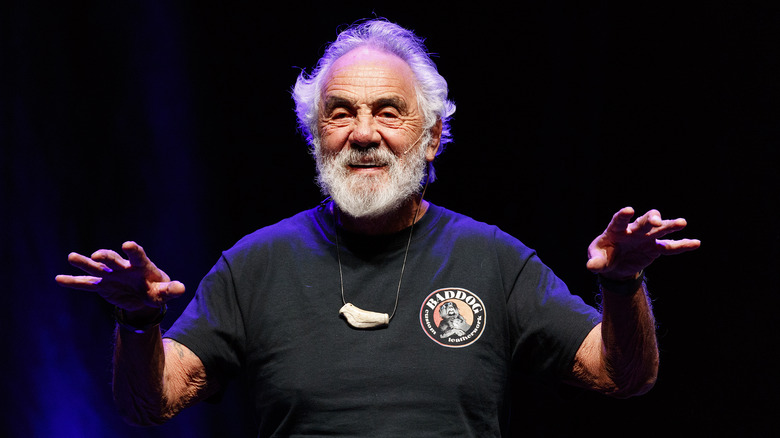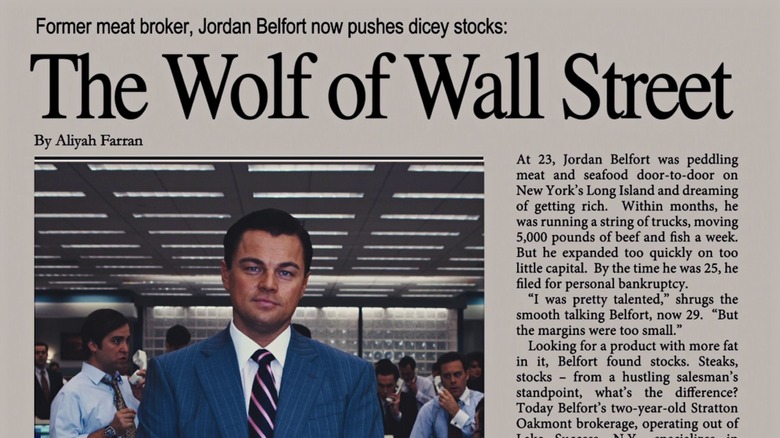Everything The Wolf Of Wall Street Doesn't Tell You About The True Story
Martin Scorsese's film "The Wolf of Wall Street" is an over-the-top celebration of greed and excess, inspired by the memoir of the notorious stockbroker Jordan Belfort, who is played by Leonardo DiCaprio in the film. It tell of the rise of Jordan Belfort from a low-level assistant at L. F. Rothschild to a Long Island penny stock pusher, as well as Belfort's dramatic fall from filthy rich CEO of Stratton Oakmont to a stint in federal prison for stock fraud and money laundering.
Despite being ostensibly based on a true story, many question the veracity of the film because of how absolutely outlandishness of Belfort's claims, and how outrageous the antics at Stratton Oakmont are. Scorsese obviously recognized Belfort is an unreliable narrator with a penchant for exaggeration. In the film, Belfort breaks the fourth wall, addressing the camera and the audience directly. This was a strategic choice by the screenwriter and director. Screenwriter Terence Winter told Esquire, "Jordan is talking directly to you. You are being sold the Jordan Belfort story by Jordan Belfort, and he is a very unreliable narrator. That's very much by design."
Despite how unlikely this story is, most of what transpires in the film actually happened. Winter added, "I assumed he must've been embellishing. But then I did some research, and I talked to the FBI agent who arrested him, who had been tracking Jordan for ten years. And he told me, 'It's all true. Every single thing in his memoir, every insane coincidence and over-the-top perk, it all happened.'"
That said, this film is Belfort's truth, not necessarily the definitive truth. Keep reading if you want to learn everything "The Wolf of Wall Street" doesn't tell you about the true story of Jordan Belfort's meteoric rise and fall.
Belfort's wives' names were changed for the film
Although their real-life counterparts are obvious, the names of Jordan Belfort's ex-wives were changed in the film, giving the filmmaker creative license with the characters. Belfort's first-wife in the film is Teresa Petrillo (Cristin Milioti), but her real-life counterpart is Denise Lombardo. Denise met Belfort in high school, and the childhood sweethearts married in 1985 after Denise graduated from college. Belfort founded Stratton Oakmont while married to Denise, and they divorced after she found out about his affair in 1991 (per The U.S. Sun). After their divorce, Denise led a low-profile life, staying out of the public eye.
Belfort's second-wife in the film is Naomi Lapaglia (Margot Robbie). Naomi's real-life counterpart is Nadine Macaluso. Like Naomi, Nadine was a model and met Belfort at a party before they married in 1991. Nadine and Belfort had two children together and separated in 1998 as depicted in the film (per the U.S. Sun). Nadine got a Ph.D, becoming a marriage and family therapist. She lives in California with her second husband (per Daily Mail TV).
Margot Robbie, who played Naomi in the film, met Nadine while preparing for her role. Robbie told IndieWire meeting Nadine helped her understand her character's motivations, saying, "I could do or say any horrible thing and know that my character's motivation was out of protection for her child. Whether or not the audience sees my side of events is another matter, but just to know my motivation can give me an authentic performance." She added how strong Nadine is, saying, "She's has to be, to have put up with Jordan and his shenanigans."
The original crew Belfort recruited from friends are composite characters
Although Belfort recruited the original crew for his Long Island brokerage firm from a group of friends; Alden "Sea Otter" Kupferberg (Henry Zebrowski), Robbie "Pinhead" Feinberg (Brian Sacca), Chester Ming (Kenneth Choi), and Nicky "Rugrat" Koskoff (PJ Byrne) are composite characters with fictitious names. These characters are an amalgamation of numerous people who worked at Stratton Oakmont and do not represent actual people.
This didn't stop Andrew Greene, a board member of Stratton Oakmont, from filing a defamation suit against the film's production company. He was offended by the depiction of "Rugrat" in the film, saying the character damaged his reputation. He called the character a "criminal, drug user, degenerate, depraved and devoid of any morals or ethics" (per The Guardian).
In 2018, Greene lost his suit. In 2020, an appellate court threw the suit out, stating that the filmmakers, by creating composite characters and fictitious names, "took appropriate steps to ensure that no one would be defamed by the Film," (per the Hollywood Reporter). The filmmaker included the hijinks of the employees at Stratton Oakmont in the film to illustrate the raucous corporate culture of the brokerage firm, rather than defame former employees.
Donnie Azoff doesn't exist, his real-life counterpart is Danny Porush
Jonah Hill's character Donnie Azoff in "The Wolf of Wall Street" doesn't exist. He is a composite character created to avoid defaming anyone while making the film. To anyone who is familiar with Jordan Belfort and Stratton Oakmont's story, it's obvious Danny Porush is Azoff's real-life counterpart. Porush disputes the veracity of both Belfort's memoir and the film, telling Mother Jones, "The book ... is a distant relative of the truth, and the film is a distant relative of the book." Porush admits to swallowing the goldfish, but under different circumstances than depicted in the film.
As reported by Mother Jones, Porush was Belfort's friend and business partner between 1988 and 1996. Like Belfort, he cooperated with authorities, ultimately serving 39 months in prison for his securities and financial crimes at Stratton Oakmont. Porush disputes the throwing of dwarves, insists there were never animals in Stratton Oakmont — other than the goldfish he ate — but admits to the wild parties and taking part in the depravity and excesses encouraged at the brokerage firm, saying "Stratton was like a fraternity."
Porush told Mother Jones, "My main complaint [regarding the memoir] besides his inaccuracy was his using my real name," something that was remedied when the filmmakers created the composite character of Donnie Azoff. Ultimately, Porush doesn't seem to hold a grudge despite his grievances with the inaccuracies saying, "Hey, it's Hollywood ... I know they want to make a movie that sells. And Jordan wrote whatever he could to make the book sell."
Danny Porush's wife introduced Jordan Belfort to her husband
In "The Wolf of Wall Street," Donnie Azoff (Danny Porush's fictional counterpart) approaches Belfort at a restaurant about what he does for a living, after seeing Belfort's Jaguar in the parking lot. In reality, Belfort met his future business partner, Danny Porush, through Danny's wife Nancy.
Porush and Nancy lived in the same building in Queens where Belfort lived with his first wife Denise, as Nancy told Doree Lewak with The New York Post in 2013 shortly before "The Wolf of Wall Street" came out. Nancy explained how she took the same bus into the city for work as Belfort, saying, "the commute to the city each day was hard because I became pregnant right away. There was a nice boy from our building on the same bus who always gave up his seat for me. His name was Jordan Belfort, and he worked in finance ... I pushed Danny to talk to Jordan ... After just one conversation, Danny came back and announced he was taking the Series 7 exam to get his stockbroker's license."
In the New York Post article, Nancy detailed how her husband changed once he began working with Belfort and making serious cash, saying, "Up until then, Danny never seemed to care about money ... I saw him morph from a nice wholesome guy into showy narcissist whom I hardly recognized anymore." After being arrested for securities fraud, Porush left Nancy for another woman. They are now divorced, and he lives in Florida with his second wife. We can't help wondering if Nancy ever regrets introducing her ex-husband to Belfort.
Belfort's destroyed yacht once belonged to Coco Chanel
Jordan Belfort bought a yacht and named it after his second wife. In the film, the boat is named Naomi after the character played by Margot Robbie, but in real life the boat was called the Nadine. True to the film, Belfort insisted his boat's captain take the yacht into choppy waters, where the boat happened upon powerful but unpredictable mistrals, leading to the Nadine sinking into the Mediterranean Sea in an event known as Mayday In The Med. Belfort, his guests and crew, were rescued by the Italian coast guard.
What the film doesn't tell you is that Belfort's yacht had an interesting past. Belfort's vintage yacht once belonged to none other than the famous French fashion designer Coco Chanel. Chanel is known for her outspoken nature and is associated with quite a few fiercely female quotes. Chanel is quoted as saying, "As soon as you set foot on a yacht, you belong to some man, not to yourself, and you die of boredom." Rather than avoid luxury yachts all together, Chanel made the boss move of buying her own in 1961, naming her the Matilda (per Boss Hunting).
As bizarre as this interlude of the film was, it actually happened, with one major difference. In an interview with The Room Live, Belfort explained how the group waiting to be rescued had to push the helicopter off of the boat to make room for a rescue team to lower down onto the yacht. In the film, the waves knock the helicopter off of the yacht. Belfort also explains that although his private jet also crashed, it was 10 days after the yacht sunk, not at the same time, as it was depicted in the film for dramatic effect.
Steve Madden spent time in prison for stock fraud
Although they don't talk about it in the movie, Steve Madden also went to prison for stock fraud and money laundering along with Jordan Belfort and Danny Porush. The New York Times reported in 2002 that Madden "was arrested in 2000 as a result of an investigation of a scheme to manipulate 23 initial public stock offerings underwritten by the companies Stratton Oakmont and Monroe Parker Securities ... It included the initial public stock offering of his own company in 1993."
True to the film, Danny Porush, Azoff's real-life counterpart, really was childhood friends with Steve Madden. Like Belfort and Porush, Madden loved debauchery and Quaaludes, so much so he didn't finish college because of how much he was partying. Although Madden wrote about his wild days in his memoir, his time partying with the Stratton Oakmont "fraternity" was not included in the film. Stratton Oakmont took Madden's company public, making him instantly rich (per The New York Post).
As reported by the New York Post, Madden wrote about this period of his life in his memoir "The Cobbler: How I Disrupted an Industry, Fell from Grace & Came Back Stronger Than Ever." In his book, Madden wrote, "Jordan was like no one else I have ever met before or since. He became one of the most influential people in my life ... I was pumping and dumping [stocks] right alongside them." Madden wound up serving 31 months for his financial crimes and his involvement with Stratton Oakmont's schemes. Unlike Porush and Belfort, Madden could continue working at his company after being released from prison.
Belfort was ordered to pay restitution to his victims
When Belfort was convicted of money laundering and stock fraud in 2003 for Stratton Oakmont's "pump and dump" schemes, he was sentenced to four years in prison and ordered to pay over $110.4 million in restitution (per Crime Museum). Belfort only served 22 months for his crimes and a judge ordered him to pay half of his income once he was released from prison.
In 2013, just after the film was released, CNN reported Belfort had only contributed a little over $11 million to the fund for victims, much obtained from confiscated possessions. At the time the film came out, Belfort allegedly stated he would hand over all of his royalties from the film and the book. But in 2018, Fortune Magazine reported government officials claimed Belfort still owed $97 million, meaning that over the previous 5 years, Belfort only contributed an additional $2 million dollars to the victims' fund. $2 million dollars is more than most of us will ever see, but Belfort is still making good money as a motivational speaker.
As reported by Fortune Magazine, there is a disagreement between Belfort's attorneys and prosecutors over what income can be garnished for restitution. Belfort reportedly earned around $9 million dollars between 2013 and 2015, but neglected to pay half of those earnings to the victims' fund. Although Belfort claims he will feel better after he has paid the money back, he doesn't seem to be fulfilling his end of the court order. Belfort obviously still enjoys a life of luxury and it is hard to reconcile his claims of being reformed with his reluctance to pay the restitution to his victims. In her New York Post article Nancy Porush reminded us, "Greed is not good — it's ugly."
Tommy Chong was Belfort's cellmate in prison
"The Wolf of Wall Street" ends with Jordan Belfort in a cushy white-collar prison with tennis courts, but the film didn't tell us who Belfort's cellmate was. Belfort and Tommy Chong of the comedy duo "Cheech & Chong" were cellmates before Chong was released. In 2014, Belfort spoke to Stephen Galloway with The Hollywood Reporter about his time in prison. He explained, "[Chong] was in the process of writing his book. We used to tell each other stories at night, and I had him rolling hysterically on the floor. The third night he goes, 'You've got to write a book.' So I started writing, and I knew it was bad. It was terrible. I was about to call it quits and then I went into the prison library and stumbled upon 'The Bonfire of the Vanities' by Tom Wolfe, and I was like, 'That's how I want to write!'"
In 2014 Chong spoke with Adrian Lee at Maclean's about how he met Belfort in prison and giving Belfort feed back on his pages, saying "After a while he showed me what he had written, and it was the only time I had critiqued someone really heavy — usually when someone writes something, you say, 'Oh yeah, that's great, keep going.' But I knew instinctively he had a lot more to offer than what he showed me ... I told him ... 'No, you've got to write those stories you've been telling me at night. Your real life is much more exciting than any kind of imaginary story you could come up with.'"
Stratton Oakmont was never on Wall Street
Although the memoir and film are titled "The Wolf of Wall Street," Jordan Belfort only worked on Wall Street for several months in 1987 at L. F. Rothschild. Black Monday put an end to his days at a Manhattan based brokerage firm. As we see in the film, it was on Long Island that Belfort got a job at the Investor's Center selling penny stocks from the pink sheets and found his calling: his get-rich-quick scheme, selling nearly worthless stocks for a 50 percent commission to people who couldn't afford to lose the money (per NY Times).
Belfort soon went out on his own, founding Stratton Oakmont with Danny Porush, where they began targeting rich investors using a persuasive script and "pump and dump" tactics — making Belfort, Porush and their brokers rich, while leaving their clients broke. As reported by the Washington Post in 1996, Stratton Oakmont was disciplined for securities violations as early as 1989, and continued to be disciplined almost annually.
Jimmy So with The Daily Beast, maintains, "The problem with 'The Wolf of Wall Street' is that the self-fashioned wolf was nowhere near the real Wall Street." The memoir and film made the brokerage firm seem like a much bigger deal than they really were, despite the financial ruin they left in their wake. Stratton Oakmont's offices were on Long Island, not Wall Street.
Jordan Belfort was never called 'The Wolf of Wall Street'
Scorsese's film makes it seem like Forbes gave Jordan Belfort the nickname, "The Wolf of Wall Street" when they published a takedown about Stratton Oakmont's questionable business practices. Forbes wrote an article about Stratton Oakmont's dirty deeds in 1991, but the article did not call Belfort "the wolf of wall street." In 2013, Forbes revisited Roula Khalaf's original article, where she called Belfort a "twisted Robin Hood who takes from the rich and gives to himself and his merry band of brokers."
Danny Porush, Belfort's former partner and one-time friend, told Mother Jones that nobody at the firm ever used the "wolf" moniker. As reported by CNN, Belfort came up with the nickname himself for his memoir. As Porush told Mother Jones, Belfort's "greatest gift was always that of a self-promoter." But as Joe Nocera with the NY Times said, "who would ever buy a ticket to a movie called 'The Wolf of Long Island'?"
Belfort had a head-on collision while driving under the influence of Quaaludes
When the real Jordan Belfort crashed his car while on Quaaludes, he was in a Mercedes Benz rather than a Lamborghini, and someone was actually injured. Belfort had a head-on collision while driving home from the country club where he used the pay phone, sending the woman he collided with to the hospital (per The Daily Beast). None of Belfort's crimes are victimless.
This type of discrepancy is central to the complaints about both Belfort's memoir and the film. Although Belfort says he regrets his crimes, he is too busy boasting about the parties, the riches, the drugs, and the sex to sound like he regrets anything except getting caught. Belfort's memoir and the film it inspired might seem like a celebration of greed and excess, but they are also a depiction of the ostentatious behavior that eventually drew the attention of the authorities.
Scorsese's "The Wolf of Wall Street" might not tell you everything about the true story, but what it does is reveal how audiences love watching someone else's destructive behavior. We get all the thrills and none of the consequences. As screenwriter Terence Winter told Esquire, "I'd much rather watch somebody who isn't responsible, who makes all the wrong decisions and hangs out with the wrong people. That's more satisfying. We may live like saints, but when it comes to our fantasy life, everybody's got a little larceny in their soul."
